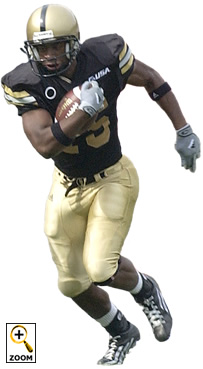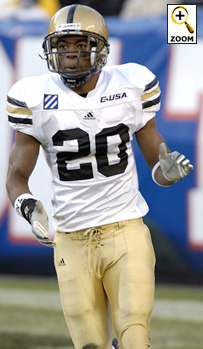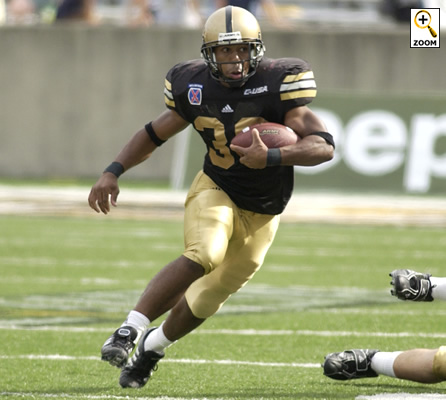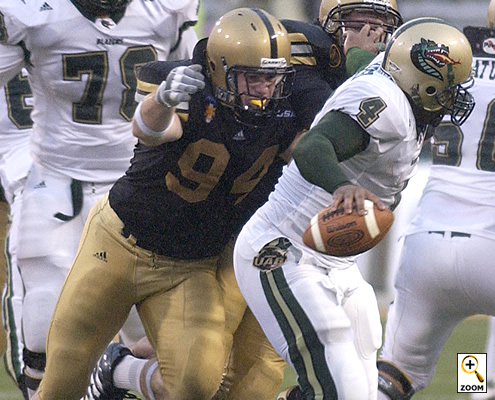 |
| WR
Jeremy Trimble |
|
|
|
2004
Statistics
|
Coach:
Bobby Ross
2-9,
1 year |
|
2004
Record: 2-9
|
|
| LOUISVILLE |
LOST
21-52 |
| at
Houston |
LOST
21-35 |
| at
Connecticut |
LOST
3-40 |
| TCU |
LOST
17-21 |
| CINCINNATI |
WON
48-29 |
| at
South Florida |
WON
42-35 |
| at
East Carolina |
LOST
28-38 |
| AIR
FORCE |
LOST
22-31 |
| at
Tulane |
LOST
31-45 |
| UAB |
LOST
14-20 |
| vs.
Navy |
LOST
13-42 |
|
2004 Final Rankings
AP-UR, Coaches-UR, BCS-UR
|
|
2005
Outlook
|
|
Entering
its 116th season of football (fifth oldest
I-A program still competing), Army will
try to avoid ending up ranked around that
higher number in most defensive statistical
categories. That type of finish for this
campaign, the second of Ross' rebuilding
project, would be disheartening. Though
the Cadets have many miles to go, the veteran
coach has brought back much of the positive
energy and flow that needs to be kindled
if any program is to regain its foundation.
This
season shouldn't be "back to Square
One". Last fall's 2-9 finish didn't
appear special, but the team took some of
those all-important small steps. The offense,
specifically the ground game, proved to
be solid. Of those nine losses, only three
were by more than two TDs. If the defense
can improve just marginally enough, and
the offense can maintain last year's performance
level, this team will be more competitive,
and wins will soon follow.
The
good news is that Army has ditched C-USA
for an independent schedule, which is just
what a program trying to build from rock-bottom
needs. This year's slate is easier, though
it still includes four bowl teams. Opening
at Boston College won't be the early blow
many think, but a good measuring stick which
can then help to gauge further improvements.
There are six home games and some softies
late in UMass and Arkansas State, but nothing
is a "sure win" until consistency
is in place.
This
program still needs to recruit and develop
bigger, faster players. Adding veteran Dan
Baranik as recruiting coordinator is a needed
move that should pay dividends, just not
immediately. As prototypes, if Navy and
Air Force can do it in our modern times,
so can Army. But, for now, three wins and
a more competitive showing against Navy
would make for an acceptable season. With
the Midshipmen also revamped, there will
be many more pushups to do come December
3rd.
Managing
the turnover of Cadet personnel, especially
during wartime, is more challenging than
in most programs, so any defensive improvements
would signal that this program is genuinely
building a future for itself even as we
write (and you read) this preview. We see
them stepping up enough to possibly clear
the three-win bar. Small steps…
Projected
2005 record: 4-8
|
|
 |
| CB
Dhyan Tarver |
|
ARMY
*POWER RATINGS
|
|
Offense
|
Defense
|
| QB
- 3 |
DL
- 1.5 |
| RB
- 3.5 |
LB
- 1.5 |
| WR
- 3 |
DB
- 2 |
| OL
- 2 |
.. |
|
|
RETURNING
LEADERS
|
|
Passing:
Zac Dahman, 265-145-7, 1767yds., 9 TD
Rushing: Carlton Jones, 209 att.,
1269 yds., 17 TD
Receiving: Jacob Murphy, 26 rec.,
357 yds., 2 TD
Scoring: Carlton Jones, 17 TD, 1-two
pt. conv., 104 pts.
Punting: Tom Dyrenforth, 66 punts,
32.9 avg.
Kicking: Austin Miller, 4-5 FG, 23-27
PAT, 35 pts.
Tackles: Dhyan Tarver, 83 tot., 57
solo
Sacks: Cameron Craig, 4 sacks
Interceptions: Ray Stith, 2 for 8
yds.
Kickoff returns: Scott Wesley, 54
ret., 23.1 avg., 1 TD
Punt returns: Corey Anderson, 11
ret., 4.6 avg., 0 TD
|
|
|
|
|
|
|
OFFENSE
- 5
|
----RETURNING
STARTERS----
|
DEFENSE
- 5
|
|
|
KEY
LOSSES
|
| OFFENSE:
Aaron Alexander-WR, Joel Glover-OT, Seth Nieman-OT,
Tielor Robinson-RB, Justin Troy-C, Adam Wojcik-OG,
Andy Dytrych-OG, Reggie Nevels-QB/WR |
| DEFENSE:
Delente
Brewer-CB, Curt Daniels-SS, Trey Landry-DT,
Jonathan Lewis-CB, Matt Maimone-LB, Will Sullivan-DE,
Greg Washington-LB, Mikel Resnick-DB |
|
|
|
2005
OFFENSE
|
|
Quarterback
The return of Zac Dahman gives Army some long-needed
stability at this spot, at least for this season.
The senior, who has started 23 of the last 36
games and owns almost every school passing record,
regained the job after three games backing up
Reggie Nevels. Dahman has a nice arm, and even
though he is quick (4.6-sec 40), he isn't often
mobile - he stands and delivers. Bobby Ross designs
the offense around his starting QB, so don't expect
the return of the option, though QB draws could
work if employed. Actually, expect the forward
pass to be used even more. Despite relying on
the run, the passing offense remained consistent
and respectable. As long as the new-look offensive
line isn't a disaster, those stats will improve.
None of the backups has game experience. If Dahman
stumbles, the mobile Chase Laws will get the job,
changing the complexion of the offense. Dahman
could be bypassed, though, as his handling of
long snaps makes him invaluable on special teams.
Junior Conner Crehan is listed third, but we feel
he is the complete package and should be under
center if problems arise.
Running
Back
Things look good here with the return of 1,000-yard
rusher Carlton Jones and power back Seth Gulsby.
Gulsby will see time at fullback, a measure taken
to keep him on the field. Both guys have speed
and power and are fairly interchangeable. Jacob
Muraldi is listed ahead of Gulsby, though Gulsby
appears to be the ball carrier of the two. Muraldi
is their primary blocking back, especially on
the goal line. Behind them, Army's ground game
was 36th nationally (not bad for a 2-9 team).
The revamped offensive line should take some spark
out of the rushing attack, especially early on,
so Jones's receiving skills out of the backfield
will help. Jones is a well-rounded back, with
inside and outside abilities that have made him
the team's leading rusher every season he has
played. The blocking of Gulsby and junior Miraldi
are the key. Scott Wesley is a return specialist
capable of stepping in where/if Jones lets off
or is injured. Depth drops off from here quite
a bit, so health is a concern in this unit.
Receiver
Dahman doesn't have the world's greatest athletes
to throw to, but he has several solid players
who comprise a decent unit. Lanky Jacob Murphy
(T-2nd team catches) knows how to get open, and
he becomes the go-to guy with the graduation of
Aaron Alexander. Sophomores Corey Anderson (only
5'8") and Jeremy Trimble (17.5 yards per
catch), who both saw some time last fall, are
a pair of (potential) deep threats who should
open up the underneath for Jones and Murphy. Trimble
was named to the 2004 Conference USA All-Freshman
Team after appearing in all 11 games of his rookie
campaign. His skills can be traced back to his
father Steve, who was a former All-ACC defensive
back for the Maryland Terrapins during the Jerry
Claiborne era (1976-80) and later played for the
NFL Denver Broncos.
Anderson, though, was the team's third-leading
rusher, too (five carries at 21.5 per), so his
number of touches (mere two catches) will surely
surge. The return of oft-injured Bruce Brown,
who missed the spring, would give Dahman a third
burner. If the running game struggles behind the
new line, the passing game will be able to hold
its own.
Tight
End
Big Texan Jared Ulekowski, the team's fourth-leading
receiver, gives Dahman another reliable target,
both in the middle deep and on short routes. More
importantly, he's an experienced blocker on an
inexperienced line, as is backup Tim Dunn, who
is considered a better blocker than Ulekowski.
Expect plenty of double-TE sets.
Offensive
Line
We already know the defense is going to be marginal,
so we call this the team's most pivotal area.
If that productive running game grinds to a halt
and Dahman has to run for his life, this team
will take a step backwards. Four starters on an
underrated group that allowed just 17 sacks (third
in Conference USA) are gone, leaving C Pete Bier
as the anchor. Senior RG Regan Tatford is the
only other letterman listed on their three-deep,
so at least the inside will have some early reliability.
Most I-As can manage turnover and then reload
in these situations, but this is a program with
three wins in the past three seasons and a roster/recruiting
that reflects the current war(s). This was the
primary offensive focus this spring, and Ross
said he likes what he saw. If that's not just
wishful thinking, the offense should remain productive.
Otherwise…
OFFENSIVE
BREAKDOWN
In case you missed the unit breakdowns, it all
begins and ends with the front five. Defenses
will surely stuff the box to take advantage of
the inexperienced line and/or stop Jones. Don't
expect Dahman's escape-ability to save the day.
The line will likely struggle early while assignments
are mastered and cohesion is built. Once it solidifies,
the pass should be sneaky enough to not only open
up the run, but score points. Meanwhile, the skill
people will have to maintain their discipline
(16th nationally for least turnovers lost), while
finding a way to be more efficient on third downs
(just 33 percent). There are a lot of 'ifs' here,
but this could very well be a respectable offense
by season's end. For this program, those baby
steps should be the focus and feel like accomplishments
when achieved consistently. Those will become
the building blocks for the program to really
set a foundation for the future, so the line's
adjustment-time will eventually pay dividends.
|
 |
|
RB
Carlton Jones
|
|
|
ARMY
2005 DEPTH CHART
Returning Starters in bold
|
|
OFFENSE
|
| QB |
Zac
Dahman-Sr (6-0, 179) |
David
Pevoto-So (6-3, 211) |
| FB |
Mike
Viti-So (5-10, 242) |
Tim
Frye-Fr (5-10, 230) |
| RB |
Carlton
Jones-Sr (5-9, 197) |
Seth
Gulsby-Sr (6-1, 209)
Scott Wesley-Sr (5-11, 202) |
| WR |
Jacob
Murphy-Sr (6-2, 206) |
Bruce
Brown-Jr (5-10, 179) |
| WR |
Jeremy
Trimble-So (6-0, 212) |
Corey
Anderson-So (5-8, 161) |
| TE |
Jared
Ulekowski-Sr (6-3, 244) |
Tim
Dunn-Jr (6-5, 243) |
| OT |
Ray
Zelenak-So (6-2, 255) |
Nathan
Collier-Jr (6-6, 294) |
| OG |
Matt
Weisner-Jr (6-2, 280) |
Dan
Evans-Sr (6-2, 281) |
| C |
Pete
Bier-Sr (6-4, 282) |
Trey
Miranne-So (6-1, 256) |
| OG |
Miles
Murray-Jr (6-2, 280) |
Connor
Wicklund-So (6-3, 262) |
| OT |
Jonathan
Connon-Jr (6-6, 287) |
Steven
Westbrook-So (6-5, 250) |
| K |
Austin
Miller-Jr (6-2, 207) |
Justin
Koenig-Jr (5-10, 176) |
|
|
|
2005
DEFENSE
|
|
Defensive
Line
Calling this unit the strength of the defense
is like dubbing the quickest in a lineup of snails,
especially considering that Army was the worst
defense in Division I-A (allowing 490 yards per
game). But two of the four returning starters
are here, and there's plenty of badly needed new
blood, though the group is still undersized. Ross
was particularly pleased with the play of his
ends, who should provide more pressure to help
an overmatched secondary. DE Cameron Craig led
the team with four sacks despite getting the starting
job four games into the season, and sophomore
Brandon Thompson brings athleticism on the other
side. Inside, there's experience with Seth Lotts,
Doug Meyer and Tommy Ryan, though those guys contributed
to a run defense that was 115th in the country.
Size issues exist for this group as a whole. Starting
with rushing first-downs (148) and ground scores
(29 TDs), this unit can improve just by affecting
these areas. The line should reflect many off-season
adjustments - could it be any worse?
Linebacker
Ross likes the development here as well. And again,
there's not much size, so this group will have
to rely on speed and just plain nastiness. Cason
Shrode, who takes over in the middle, bulked up
in the offseason and seems to have the right mentality,
though his stat line needs more big plays. Shrode
is the only LB listed over 230. Luke Pell, who
missed the spring with a hamstring problem, is
one of the few LBs with experience. He should
beat out converted-safety Charlie Rockwood for
the strong-side spot. Barrett Scruggs and Taylor
Justice are battling for the weak-side job. Both
can cover plenty of ground and tackle well. Scruggs
may be the most poignant of the entire corps,
so expect to see him wherever the play goes. Only
Rockwood breaks the usual Cadet tradition of playing
upperclassmen, so experience either pays off or
again weighs the D down.
Defensive
Back
The staff has done some juggling to try to stop
the bleeding, including switching to a more traditional
4-3 and reformulating the CBs' role(s). The leader
here is Dhyan Tarver, who was moved from free
safety to corner, an area where this unit was
consistently torched. Tarver stands as the leading
returning tackler and is a legit pro prospect.
He'll play "boundary" corner, which
is designed for physical players. Ray Stith, a
senior who started frequently at corner, is considered
the top cover guy and will play "field"
corner. He'll (have to) be a year better. Soph
Caleb Campbell moves to strong safety after starting
in the "Whip" spot, and Randy Chasten
takes over at free safety. Both guys are strong
and vastly more experienced than their backups,
though Chasten had not one stat-worthy play outside
of his tackles, and as a safety, he has to ball
hawk more while coming close to leading the team
in tackling. Seven INTs as a group won't do, so
look for more takeaways to signal/represent a
more sound foundation that, once in place, can
take the risks needed, not just "barely keep
up".
DEFENSIVE
BREAKDOWN
This defense has no where to go but up, and the
potential is there for improvement, especially
against the run. The move to a 4-3 should result
in more penetration, which would help a secondary
that can expect to be tested often. Guys like
Tarver, Shrode and Craig will step up their games
so that their intensity lifts those around them.
But, most likely, lack of size will be a detriment
against the run, and their overall lack of athleticism
(there are exceptions) will hurt the pass defense's
efficiency. The question is, how badly? The good
news was that the Cadets held foes to 52 total
first-quarter points - Army actually aggregately
actually won the opening frame, as they did the
fourth, so it became foes' adjustments that killed
them. An adaptable, semi-dynamic 60-minute effort
on D will surely mend many of the team's ills.
Again, it's all about baby steps, and any defensive
consistency will represent important ones.
|
 |
|
DE
Cameron Craig
|
|
|
ARMY
2005 DEPTH CHART
Returning Starters in bold
|
|
DEFENSE
|
| DE |
Brandon
Thompson-So (6-3, 244) |
Peter
Harrington-Jr (6-4, 253) |
| DT |
Tony
Fusco-So (6-1, 295) |
Doug
Meyer-Sr (6-5, 263) |
| DT |
Tommy
Ryan-Sr (6-2, 275) |
Seth
Lotts-Sr (6-3, 243) |
| DE |
Cameron
Craig-Jr (6-3, 247) |
John
Wright-So (6-2, 248) |
| SLB |
Charlie
Rockwood-So (6-2, 214) |
Luke
Pell-Jr (6-0, 212) |
| MLB |
Cason
Shrode-Jr (6-2, 246) |
Brian
Chmura-So (6-0, 229) |
| WLB |
Barrett
Scruggs-Jr (6-0, 209) |
Michael
Herndon-Jr (6-0, 219) |
| CB |
Ray
Stith-Sr (5-9, 176) |
Sean
Grevious-Jr (5-10, 173) |
| CB |
Dhyan
Tarver-Sr (5-11, 186) |
Chris
Grevious-Jr (5-10, 177) |
| SS |
Caleb
Campbell-So (6-2, 233) |
Jordan
Murray-So (6-0, 200) |
| FS |
Randy
Chasten-Jr (6-2, 205) |
Rob
Davis-Sr (5-11, 201) |
| P |
Owen
Tolson-So (6-2, 200) |
Tom
Dyrenforth-Sr (5-10, 188) |
|
|
|
|
|
2005
SPECIAL TEAMS
|
|
Kicker
With spring ball over, there are still five different
kickers in the mix, with no clear front-runner. For
what it's worth, junior Justin Koenig was 1-of-3 on
field goals last fall, and returning starter Austin
Miller hit 4-of-5 while missing four PATs. Coverage
improvements will parallel those of the entire defense,
so if the D is strong, coverage likely gets better.
Punter
Owen Tolson, a sophomore, beat out incumbent Tom Dyrenforth
this spring. That's probably a good thing -- Dyrenforth
consistently hurt Army's field position (36.9 per try).
Tolson had a 52-yarder in the spring game, when he averaged
46.3 yards. Adjustment will come on defending returns
(8.1 per try, but no TDs), too, as the increase in hangtime
can allow for that extra second needed to turn this
department around.
Return
Game
Besides defense, one of the most embarrassing aspects
of this team was punt returns. At just 4.9 yards per
try, Army ranked third-to-last in Division I-A. The
speedy Anderson will likely get a crack here. It has
to get better, right? Kick run-backs, one of the few
bright spots on special teams, should remain stellar
as Scott Wesley returns. The senior was fourth in C-USA
at 23.1 yards per.
|
| |
| |
|
|
|